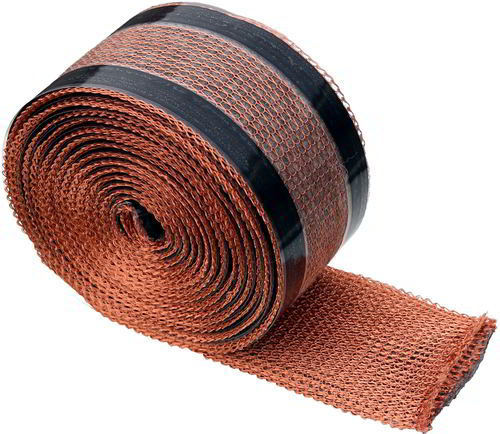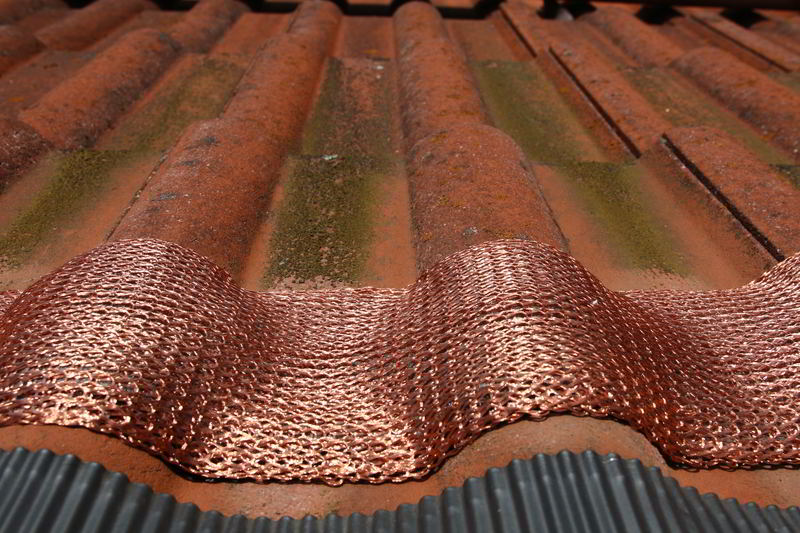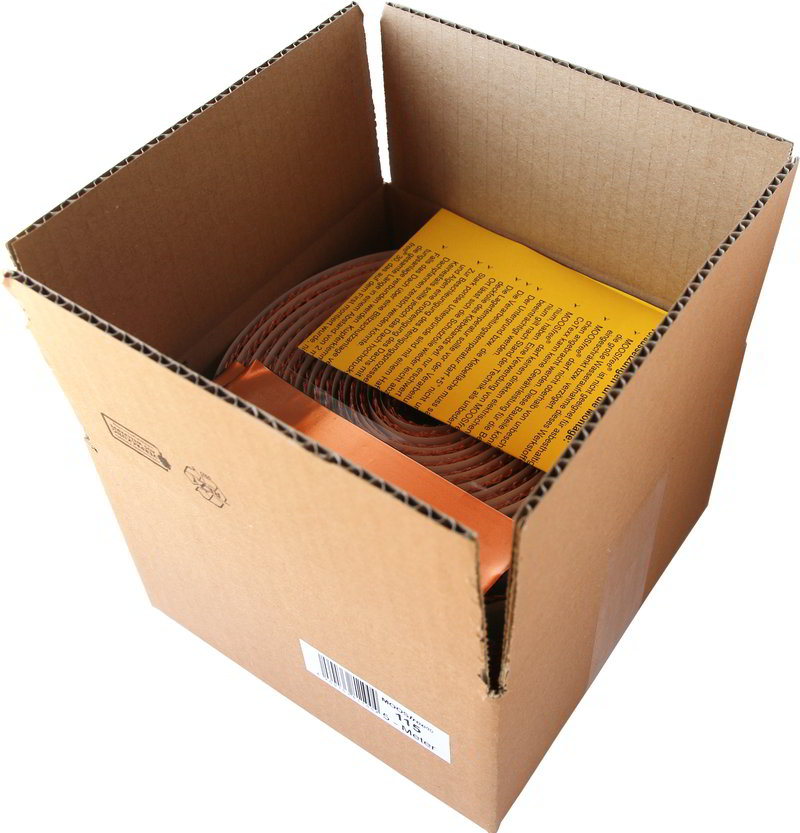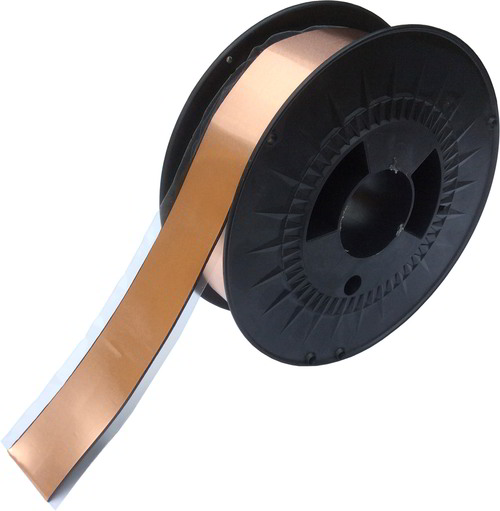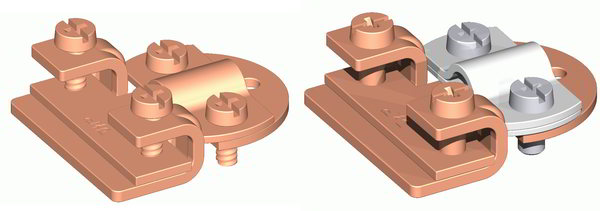MOOSfree®
The Copper Tape Against Moss
and Algae on the Roof
MOOSfree®
Key Factor to Stop Moss, Algae and Lichens from Growing :
A Large Active Copper Surface
8900 m of pure copper wire are processed for every meter of MOOSfree 115 - a distance larger than the elevation of Mount Everest!
The diameters of the individual wires are 50 - 100 micrometers - as thick as a human hair.
170 cm: Such a wide sheet of copper would have to be attached to the roof in order to achieve the same effect against moss and algae as our copper tape.
The effectiveness of copper against moss, lichens and algae is generally well known. Best examples are the clean roof areas below copper-panelled chimneys and dormers.
The relevant effect is achieved by CU 2+ ions, which the copper releases over time. In organic farming this active component is in use as crop protection agent for the last 140 years. (for more information see e.g. “Demeter – Copper in Organic Farming”)
A simple copper sheet or a copper foil with a width of e.g. 15 cm can only achieve a limited cleaning effect on the roof surface, because of the small amount of ions washed out by rain. This also applies if the copper foil is perforated or otherwise textured, because the surface is hardly increased compared to a flat copper sheet. If you want to use the copper effect for moss removal and holding the entire roof length free of moss and lichen, enough copper surface must be exposed to corrosion.
The 11 cm wide standard tape MOOSfree® 115 has the same copper surface as a 1.7 m wide copper sheet.
In addition, the effectiveness of this enormous copper surface area is nearly doubled due to the inclusion of a water-storing fleece, which buffers continually produced copper ions. It prevents copper ions from being completely washed out at once by the next rainfall. Instead the copper ions are dispersed on the roof surface over a long period of time. This enables them to have a big inhibitory effect on moss, lichens and algae. Rain, snow and wind gradually free the roof tiles from the dead plants. This is how the copper tape, starting from the ridge, cleans the roof.
The experience and feedback of craftsmen as well as house owners have been incorporated into the continuous development of MOOSfree® since 2003.
Which MOOSfree®-Type for which Roof?
Components of the Moss Removal System
MOOSfree 30
For the Ridge- 2 layers of knitted copper fabric
- Active surface equals a copper sheet of 30 cm width (0,3 m²/running meter, copper mass 65 g/m)
- No water-storing fleece
- Cleaning length below the ridge max. 2 m
- Fields of application: below roof windows, dormers and fans with a distance to the gutter of less than 2 m
- Or installation on the ridge to keep the ridge area free of moss. In this case, MOOSfree® 115 or 170 can be installed two row of tiles below the ridge.
MOOSfree 115
The Standard- 4 layers of knitted copper fabric
- Active surface equals a copper sheet of 170 cm width (1,7 m²/running meter, copper mass 250 g/m)
- Water-storing fleece
- Cleaning length below the ridge max. 10 m
- Field of application: roofs of residential buildings with a rafter length of up to 10 m
MOOSfree 170
With Maximum Copper Surface- 6 layers of knitted copper fabric
- Increase of the active surface of 65% compared to MOOSfree® 115 (2,8 m²/running meter, copper mass 380 g/m)
- Water-storing fleece
- Cleaning length below the ridge max 15 m
- Fields of application: especially for roofs with longer rafter lengths up to 15 m like public buildings (churches, schools, kindergartens, authorities)
Packaging Units
MOOSfree® is delivered in cartons with rolls of 5 and 10 meters in length. Please take the waviness of the roof tiles into account when ordering. The additional demand in case of moderate waviness, compared to the stretched length (ridge length), is typically 10% to 15%..
Completion Tape
Each carton of MOOSfree® contains several 13 cm long pieces of completion tape. Completion tape is a 40 mm wide copper foil, which is coated on the back side with butyl adhesive tape. Herewith all cut edges and joints of two pieces of MOOSfree® aligned next to each other should be covered.
Optionally, the completion tape is also available on rolls up to 10 m in length. Fields of application are e.g. sealing tasks in roofing and plumbing.
Lightning Protection Adapters
Lightning Protection Adapters are useful for connecting MOOSfree® to existing lightening arresters. They are available as pure copper clips as well as bimetal clips (Al/Cu) and are tested and certified according to EN 50164-1 for use in combination with MOOSfree®. According to state to the art, all segments of MOOSfree® longer than 2 m have to be linked with the lightening arrester.
FAQ about CoTexx Moss Removal Tape
Why is MOOSfree® not mounted directly onto the ridge?
If MOOSfree® is mounted directly onto the ridge, then its effect will be divided between both sides of the roof. MOOSfree® is not designed for this application. If it should work on both sides of the roof simultaneously, then MOOSfree® needs to have at least double the amount of copper and copper surface area than it has at present. This would also double the price per metre. Furthermore every builder can decide wether to use MOOSfree® over his whole roof or only on the critical half with the mounting possibilities available to him at the moment. Another important factor is that as much rain water as possible should pass through the moss removing tape MOOSfree®, so that it can produce a large amount of cleaning copper ions. If it was mounted on the ridge, then only the water that actually falls on the tape itself would have an effect. The water capacity in this case would be minimal. The water capacity in the first or second row of roof tiles is already considerably greater. As a result, the water flowing out directly underneath the tape contains the greatest concentration of copper ions. On its way to the gutter, this is increasingly reduced by further rainfall, until the concentration is so small, that it no longer has any cleaning effect
How long does MOOSfree® last?
Depending on weather and environmental factors, corrosion will reduce the thickness of the ’active substance’ copper at a rate of 0.5- and max. 1-thousandth of a millimetre per year. This means, a 0.1mm thick copper wire is depleted in the worst case scenario after 50 years. In practice however, you can expect a useful life of between 50 and 100 years. So this is higher than the average life expectancy for a roof covering.
What should be taken into account concerning lightning protection in combination with MOOSfree® ?
MOOSfree® doesn’t present any additional danger concerning lightning strikes. If there is a lightening arrester in place however, then MOOSfree® must be attached to it. As a rule of thumb, all electric parts that conduct electricity which are longer than 2 m and which are closer to a lightening arrester than 50cm must be attached to it. Your lightning protection specialist calculates the exact value for the respective protection class and will gladly advises you. The attaching of MOOSfree® to the lightening arrester has been tested with components from the company “J. Proepster GmbH” according to “EN_50164 Teil 2 Klasse H”. These certified components can also be ordered from all MOOSfree® suppliers. Instructions for attachment are available in the Instruction for Mounting.
Wouldn’t it be better using MOOSfree® 170, in order to really be on the safe side concerning prevention of moss build-up on my roof?
MOOSfree® 115 is designed for cleaning a surface area of 10 m and is therefore suitable for nearly every single famil house. If used in combination with MOOSfree® 30 directly onto the ridge, the rafter length to be cleaned is further increased by one to two meters. This combination is more cost effective than using MOOSfree® 170 alone.
My house has a rafter length of 11.5 m. Do I have to use MOOSfree® 170?
Even in such situations we would still suggest that you use a combination of MOOSfree® 30 directly on the ridge along with MOOSfree® 115 in the second or third row of roof tiles. This is by far the most cost effective and elegant solution.
My gutter is made of titanium zinc. But I would really like to use MOOSfree®, can I?
There is a whole range of coatings and special paints on the market, which protect gutters made of titanium zinc from the effects of pitting corrosion in combination with using copper. Please contact our local craftsman in your vicinity, who usually has experience with these products. We would ask you to understand that CoTexx can not guarantee the quality and treatment of these coatings. The best technical solution is to use copper gutters. Copper is by far the more precious material. (keyword “Galvanic series” e.g. see Wikipedia).
I have a gutter made of zinc which I will have to change in two to three years anyway. Should I wait with using MOOSfree® until I have changed my gutters?
As you wish to change your gutters in the foreseeable future anyway, you may consider using MOOSfree® immediately and to change your zinc gutters for copper ones later. The advantages are that you have protection against moss on your roof immediately and you postpone the necessary investment for new gutters in one to two years. In any case the remaining useful life of your zinc gutter is reduced with MOOSfree®.
Can I also use MOOSfree® on a thatched or shingle roof?
Positive results have already been seen using MOOSfree® on thatched and shingled roofs. MOOSfree® can be used wherever there is a sufficiently solid surface on which to mount it. The fungicidal effect of copper against fungus affords additional protection if natural products such as thatch and shingle are used for covering roofs and thus increases the useful life of your roof. Using MOOSfree® for such materials is therefore particularly cost effective.
What does the fleece layer?
A non-rotting textile fleece is integrated in between the layers of copper fabric. With its ability to hold water and therefore to keep the copper surface moist for as long as possible, the speed of corrosion is nearly doubled. MOOSfree® therefore not only works as if it were a copper sheet of 115 cm or 170 cm wide but as if had double the width. During a summer period of fine weather, dew is regularly formed at night. The mixture of condensed water and warmth accellerates the corrosion rate. Thus a particularly high amount of cleaning copper ions are produced. Without the fleece this resulting high concentration of copper ions would be swept away with the first heavy rainfall usually towards the end of the period of nice weather and would not be able to work at all against the moss, lichen, algae and fungi. The fleece however stores the continuously produced copper ions like a sponge and then releases them equally over the surface of the roof over time (buffer effect). This ensures the optimal effect on moss, lichens, algae and fungi even in summer.
Can I still use the roof water for watering my garden?
You can use the rain water that has been collected from the roof surface to water your garden without worries. Copper salts have been used in much higher concentrations e.g. for the last 400 years in winegrowing as a spray against fungal infections (e.g. mildew). Copper ions only have a biocidal effect against certain ’lower’ plants such as fungi, lichen, algae and moss. The growth of cultured plants such as fruit and vegetables will not suffer in any way in their growth. According to what we know today, you can consume them without worry. On the other hand, special fertilizers and sprays against moss on grass work with a much higher concentration.
What should I do when I need to change a roof tile?
In case you need to change a single roof tile which has MOOSfree® stuck on it, cut the moss removal tape where the tile meets the neighbouring tile with scissors or a suitable knife. The tape that has been unstuck with a palette knife can then normally simply be stuck back onto the new tile using two stripes of butyl adhesive tape. In case you don’t have any butyl rubber handy, or if the tape is damaged while removing it, please call us or send us an eMail. We will be happy to send you replacement material as part of the service. Your local distributor and workman will also be happy to help you.
Do I need to clean my roof before mounting MOOSfree®?
The whole roof does not necessarily have to be cleaned before mounting MOOSfree®. Irrespective of this however, the Requirements for Mounting must be fulfilled for the area where it is to be applied. From an aesthetic perspective however it is recommended to consider a prior roof cleaning, in order not to benefit from a well-tended roof only after the self-cleaning process has taken place. This roof cleaning does not need to be repeated every two to five years as usual without MOOSfree®, rather it is a one-off procedure. The roof stays clean from the start. In cases where there is heavy moss, the roof should at least be given a basic cleaning before mounting MOOSfree®, so that the moss and lichen that are removed do not block the gutter drains.
How long does the self-cleaning process take once MOOSfree® has been mounted?
The self-cleaning process starts six to eight weeks after mounting MOOSfree®, where moss, lichens, algae and fungi are killed. Cushions of lightly attached moss are the first to be removed after dying. Fungi lying deep in the coarse surface of concrete tiles take longer to be eradicated. This process is enhanced by natural atmospheric conditions (Heavy showers, sleet, hail stones, snow and ice that slides off). Generally the process is complete after two to four years. Of course the material of the tiles along with the surface, orientation, original condition, climate and environmental conditions all make an important difference to the length of the self-cleaning process.
When is the best season to apply MOOSfree®?
Generally MOOSfree® can be mounted at any time of the year, as long as the Requirements for Mounting are observed. Moss can however be best attacked in autumn, because then moss blossoms particularly well given the moist weather and little sunshine. Luckily it is also in this type of weather that MOOSfree® produces the most cleaning copper ions. In winter dead moss is then mechanically removed by the snow and ice that forms and slides over it. At the latest in the following spring you should be able to see the effects of the self-cleaning.
Last but not least: What is the economic reasoning for using MOOSfree®?
The moss removal system MOOSfree® is a particularly cost effective way to clean your roof. This is shown by the comparison of total costs of different processes over 35 years – the average useful life of a roof covering. MOOSfree® implies a one-off cost of approx. € 5 / m² for a lasting well-tended roof (or € 0.14 / m² per year)! In this calculation of comparison we have deliberately not included an extension in the length of the useful life of the roof for reasons of competition law. In the example calculation provided, the investment would pay for itself as soon as the roof coating lasts 3 years longer than expected due to MOOSfree®. Undisputed is the fact that the eroding effect that moss and lichen have does not exactly increase the useful life of the affected roof.

